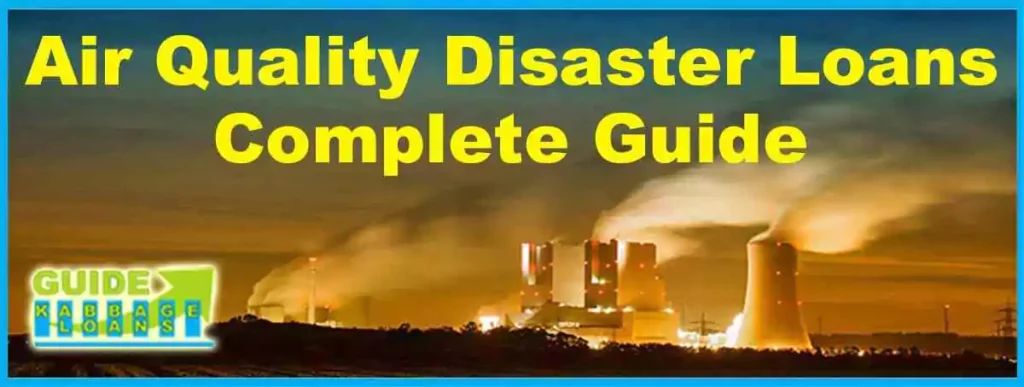Air quality is a significant concern in Carolina, with various sources of pollution impacting both human health and the environment. To combat this issue, the Biden-Harris Administration has initiated a comprehensive effort to improve air quality through the implementation of air quality disaster loans.
But in actuality, it is not a loan. These are some of the government schemes that the Biden-Harris Administration has implemented. You will get more information about them from the department. Apart from this, USA residents are searching a lot for Air Quality Disaster Loans. we have given some points about it in this article.
What are Air Quality Disaster Loans?
Air quality disaster loans are not loans in actuality. This is a group of all the schemes that have been implemented to eliminate air pollution. The Biden-Harris Administration implemented all these plans in 2022 and their group was called the Air Quality Disaster Loans. There are different terms and conditions for applying them, which all of you need to know. Below we have told about all these in detail one by one.
Air Quality Disaster Loans in Carolina.
Several plans have been implemented to reduce Carolina’s air pollution. The public can also be involved in these schemes and funding for this will be done by the government. To apply to these schemes, first, you have to select the scheme and then apply for it by following its rules.
After that, the fund is received from the government. Most complaints of air pollution are seen in Carolina. Because of this the government took these steps and these steps are called Air Quality Disaster Loans in Carolina.
How to apply for Air Quality Disaster Loans in the USA?
There is a different process for applying for Air Quality Disaster Loans in the USA. The type of scheme you want to apply for has a different process. Which you will find on the website of the United States Environmental Protection Agency and Disaster Assistance. Here all the types of schemes are explained in detail and you will find the complete process for applying for these schemes on this website.
Requirements for Air Quality Disaster Loans.
Air quality disaster loans are typically available following a declared disaster that has significantly impacted air quality. Eligible applicants, which may include individuals, businesses, nonprofit organizations, tribal entities, and government entities, can apply for these loans by submitting an application detailing the extent of the impact and their specific needs.
The loans are intended to address air quality concerns and can be used for activities such as cleanup, remediation, equipment repair or replacement, and implementing pollution control measures. The terms and conditions of the loans, including interest rates, repayment periods, and collateral requirements, vary depending on the lending institution or program.
Other Disaster Helping Schemes in Carolina

In addition to air quality initiatives, there are other disaster relief schemes available for the residents of Carolina, particularly in response to the recent storms. Both North Carolina and South Carolina have been granted major disaster declarations to assist individuals and public entities affected by Tropical Storm Helene and Hurricane Helene.
- North Carolina (DR-4827): Offers individual and public assistance to help residents recover from the impacts of Tropical Storm Helene. Eligible individuals can apply for financial support and resources aimed at repairing damages and restoring services.1
- South Carolina (DR-4829): Provides similar assistance for areas affected by Hurricane Helene. Residents can apply for aid to rebuild homes, infrastructure, and community services that were damaged by the storm.2
These disaster schemes offer crucial financial and logistical help, allowing affected areas in both states to start recovering from the storms’ impacts. Residents are encouraged to apply promptly to access the necessary assistance.
Funding for Community Air Pollution Monitoring Projects.
The EPA has recognized the urgent need to address air pollution in Carolina. To that end, the EPA has allocated substantial funding through air quality disaster loans to support community air pollution monitoring projects. These projects prioritize underserved communities that are historically marginalized and burdened by pollution.
What is the Blue Ridge Environmental Defense League?

The Blue Ridge Environmental Defense League has been selected to receive funding to purchase advanced air monitoring equipment. This state-of-the-art equipment, sourced from The J. J. Wilbur Co./Wilbur Technical Services, will be securely mounted on a covered trailer, creating a mobile unit capable of conducting air pollution monitoring.
BREDL will strategically park this mobile unit in locations across the southeastern U.S., based on confirmed needs for air pollution monitoring and secure parking arrangements. The data collected will support ongoing environmental protection campaigns led by BREDL chapters and staff.
What is Clean Air Carolina collaboration?
Clean Air Carolina, in collaboration with the Environmental Justice Community Action Network, will establish an air monitoring network in Sampson County. This initiative aims to address long-standing health inequities and environmental justice implications resulting from cumulative air pollution impacts. The monitoring network will measure particulate matter less than or equal to 2.5 microns in aerodynamic diameter (PM2.5), volatile organic compounds (VOCs), speciated VOCs, and hydrogen sulfide (H2S).
The project will focus on emissions from concentrated animal feeding operations (CAFOs), the Sampson County Landfill, and the Enviva Sampson wood pellet facility. To facilitate data collection, twenty community members, known as AirKeepers, will host low-cost sensors called PurpleAir sensors. They will actively engage in data collection and contribute to study design and implementation.
Role of “Research Triangle Institute” in Enhancing Air Quality in Carolina.
The Research Triangle Institute proposes to monitor particulate matter (PM2.5), ozone (O3), and their precursors (NOx, NO2, and SO2) at 20 childcare facilities in underserved areas of central Carolina. By collecting real-time, continuous PM2.5 data and time-weighted averages of O3, NOx, NO2, and SO2, the project aims to improve understanding of the spatial and temporal distribution of air pollution.
The project also includes training sessions on equipment use, data interpretation, and recommendations. Additionally, active air quality monitors will be donated to enrolled facilities for continued use after the project ends. The findings of this study will be shared with childcare facilities and families in an easy-to-understand format, accompanied by actionable steps to reduce children’s exposure and health risks associated with PM2.5, O3, and their precursor gases.
Importance of Air Quality Monitoring.
Air quality monitoring is crucial for understanding the extent of pollution and its impact on human health and the environment. By measuring pollutants such as PM2.5, VOCs, and other harmful gases, communities can gain insights into the air quality in their surroundings. This information empowers individuals and organizations to take appropriate actions to protect public health and mitigate the adverse effects of air pollution.
The air quality disaster loans provided by the Biden-Harris Administration enable community-based organizations and institutions to establish comprehensive monitoring systems, thus creating a network of informed stakeholders dedicated to safeguarding air quality.
Addressing Environmental Inequities.
One of the primary goals of air quality disaster loans is to address environmental inequities. Historically underserved communities often face disproportionate exposure to air pollution and its associated health risks. By focusing on these communities, the initiatives supported by the loans align with President Biden’s Justice40 Initiative and Executive Order, which aim to direct the benefits of federal investments to communities burdened by environmental and health disparities.
Through enhanced air monitoring and partnerships with communities, the EPA is striving to bridge the gap and ensure that clean air becomes a right for everyone, regardless of their zip code.
Collaborative Efforts for Clean Air.
The success of air quality disaster loans lies in the collaborative efforts of various stakeholders. Nonprofit organizations, state and local governments, and tribal governments all play crucial roles in identifying the air monitoring needs of their communities and implementing effective solutions. These loans supplement the funding provided by the American Rescue Plan and the Inflation Reduction Act, making it possible to support a larger number of projects than initially proposed.
The EPA’s commitment to engaging with community-based organizations and fostering partnerships enables a more comprehensive and inclusive approach to air quality improvement.
Long-Term Impact and Sustainability.
The air quality disaster loans provide a significant boost to community air pollution monitoring projects in the USA. The allocated funding allows these projects to operate effectively over an extended period, typically three years from the time of the grant’s award.
During this timeframe, comprehensive data on air quality will be collected, analyzed, and disseminated, informing policy decisions and guiding community-driven initiatives for sustainable change. Furthermore, by investing in clean air education and technology, the loans ensure the long-term sustainability of these efforts, empowering communities to continue monitoring and protecting their air quality beyond the project’s completion.
Conclusion.
Air Quality Disaster Loans represent a crucial step by the Biden-Harris Administration to combat air pollution, particularly in underserved areas like Carolina. Although not traditional loans, these initiatives provide vital funding for air quality monitoring and pollution control projects, aiming to create healthier environments for all.
Faq’s
How does poor air quality affect human health?
Poor air quality can have adverse effects on human health. Exposure to pollutants in the air, such as fine particulate matter (PM2.5) and ozone, can lead to respiratory issues, cardiovascular problems, and an increased risk of lung diseases. It can also worsen existing conditions like asthma and allergies.
What are the common pollutants found in Carolina’s air?
The common pollutants found in Carolina's air include particulate matter (PM2.5 and PM10), ozone (O3), nitrogen oxides (NOx), sulfur dioxide (SO2), volatile organic compounds (VOCs), and carbon monoxide (CO). These pollutants can originate from various sources, including industrial facilities, vehicles, and agricultural activities.
Thanks for your visit.
(Air Quality Disaster Loans)
Disclaimer: The information provided in this article about Air Quality Disaster Loans is intended for general informational purposes only. It is not legal advice. The term “loan” refers to government-supported schemes addressing air quality issues, not traditional financial loans. We encourage readers to consult with official government resources, such as the Environmental Protection Agency (EPA), for accurate, up-to-date details.





